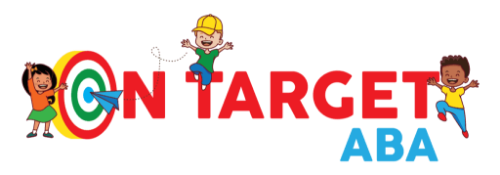🧠 AI Summary:
Ever wonder why your child’s ABA therapist takes so many notes? This blog explains how data in ABA therapy transforms everyday progress into meaningful results. Parents will learn how tracking helps personalize therapy, celebrate milestones, and ensure children grow at their own pace — one measurable win at a time.
Why Data Is at the Heart of ABA Therapy
At On Target ABA, we believe progress deserves to be seen, celebrated, and shared. That’s why data in ABA therapy plays such an important role in every child’s journey.
When you walk into a session, you might notice therapists jotting notes or tapping on tablets — even during playtime. Those moments of observation aren’t distractions; they’re how therapists track meaningful change.
According to Autism Speaks, ABA therapy uses data to identify what works best for each child — ensuring every goal is guided by evidence, not guesswork.
Each smile, gesture, or new word tells a story. Data helps us capture it.
What Does “Data” Mean in ABA Therapy?
In simple terms, data in ABA therapy is how therapists measure progress. It’s information collected during sessions that shows whether a child is learning, struggling, or ready for new challenges.
For example:
✅ “Liam used words to request toys 8 out of 10 times today.”
✅ “Sarah maintained eye contact for 10 seconds independently.”
These numbers become part of a bigger picture — showing growth that sometimes even parents can’t see day-to-day.
The CDC emphasizes that data-driven intervention allows therapists to adapt strategies quickly and effectively, improving long-term outcomes.
Why Therapists Take Notes During Sessions
It might look like a therapist is constantly recording — and they are! But it’s not just paperwork; it’s purposeful observation.
By collecting real-time data, your child’s team can:
- See which strategies are most effective
- Spot patterns (what triggers or motivates your child)
- Adjust teaching methods right away.
- Ensure every moment of therapy counts
If your child struggles with a new task, the therapist uses data to identify whether it’s too hard, too easy, or needs a different approach.
Data is how we make sure therapy stays tailored, accurate, and productive — because every child learns differently.
The Power of Data-Driven Decisions
One of the biggest strengths of ABA is that it’s a scientifically proven, data-based approach.
Each time your child practices a skill — like asking for help, sharing toys, or following directions — the therapist collects data on success rates. This data helps your BCBA (Board Certified Behavior Analyst) decide:
- When to introduce a new goal
- When to modify teaching methods
- When to celebrate mastery 🎉
This means therapy isn’t static — it grows with your child.
At On Target ABA, we say “every number tells a story.” Because behind each data point is a child who’s learning, growing, and discovering their potential.
Turning Small Wins into Big Results
Progress in ABA therapy doesn’t always happen in big leaps. Often, it’s the tiny, consistent wins that build the foundation for lifelong skills.
For example:
🧩 A child first learns to wave — then to say “hi” — and eventually starts conversations.
🧩 Another learns to match shapes — then colors — then categorize objects in everyday play.
Therapists track these micro-milestones through data, so even subtle growth is noticed and celebrated. Over time, those small steps lead to independence, confidence, and joy.
How Parents Benefit from ABA Data
Parents often find comfort and motivation in seeing their child’s progress clearly outlined in reports and charts. Data makes progress visible — especially when change feels slow.
You’ll see how many goals your child has met, what they’re currently working on, and how often they succeed in key areas.
Therapists and BCBAs use this information to show families not just that progress is happening, but how much.
This transparency helps parents feel informed, involved, and empowered — true partners in their child’s growth.
What Does a Data Sheet Look Like?
A typical ABA data sheet might include:
- Task name (“Requesting snack”)
- Type of prompt used (verbal, visual, physical)
- Number of successful attempts
- Notes on motivation and environment
Here’s an example:
| Skill | Success | Prompt Type | Notes |
|---|---|---|---|
| Saying “help” when needed | 7/10 | Verbal | Responded faster after visual cue |
| Following one-step direction | 8/10 | None | Enjoyed praise and stickers |
Behind those simple entries are hours of focused learning and collaboration between the therapist, BCBA, and family.
What Happens During BCBA Data Review
Each week or month, your BCBA reviews the data collected by your child’s RBTs. They analyze:
- Success trends
- Environmental influences (time of day, activities)
- Reinforcement effectiveness
- Behavior patterns
Then, they update your child’s therapy plan to target the next steps in development.
This constant cycle — collect, analyze, adjust — ensures therapy is always relevant and responsive to your child’s growth.
Learn more about this process in our related post: How Long Does It Take for ABA Therapy to Work?.
Data Helps Keep Everyone Aligned
ABA therapy isn’t just between a child and therapist — it’s a team effort.
Data helps coordinate communication among:
- BCBAs, who design and oversee the program
- RBTs, who implement and track sessions
- Parents, who reinforce skills at home
With data, everyone knows what’s working, what needs adjustment, and how to support consistency across environments.
How Data Motivates Children
Yes — even kids can benefit from seeing their own progress!
Therapists often use visual trackers (like sticker charts or progress boards) to show achievements. When a child earns stars or tokens, they feel pride in their progress.
This motivation boosts self-esteem and encourages continued effort. It also teaches valuable life lessons: effort leads to reward, and practice brings success.
Balancing Data with Heart
While data in ABA therapy is essential, it never replaces compassion. At On Target ABA, we know numbers tell part of the story — but love, patience, and connection tell the rest.
That’s why our therapists celebrate every victory with genuine enthusiasm. Whether it’s the first time a child says a new word or stays calm during a challenge, those moments mean everything.
Our approach combines measurable progress with emotional support — ensuring children grow not only in skill, but in confidence and happiness.
How Parents Can Support Data Collection
You don’t need to be a scientist to participate in data-driven progress! Here’s how parents can help:
✅ Communicate what you see at home — new words, behaviors, or challenges.
✅ Reinforce learned skills consistently (use the same cues and rewards).
✅ Ask your BCBA to explain data sheets during meetings.
✅ Celebrate your child’s milestones together!
Your observations at home complete the full picture of your child’s development.
Why On Target ABA Trusts the Process
At On Target ABA, every therapy plan is built on evidence, compassion, and collaboration.
We proudly serve families in:
Each center uses advanced progress-tracking systems and regular BCBA reviews to ensure your child’s plan is as dynamic and personalized as they are.
Because at On Target ABA, data doesn’t just measure growth — it celebrates it. 🌈

